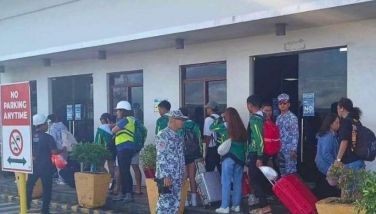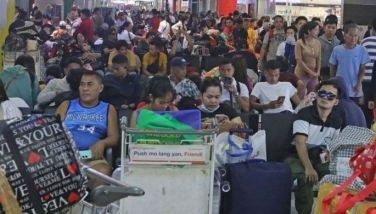Notes on the Filipino American community

I just returned from a three-week Christmas sojourn in California. My daughter Tanya Miren and her husband Edmund Duldulao and my three grandchildren now reside in Dublin, California in the region popularly known as the San Francisco Bay Area. This is the reason why I have remained interested in understanding the continuing evolution of the culture of the Filipino American community.
There are more than four million Filipino Americans in the United States. They comprise the second largest (next to Chinese Americans) Asian American group and the largest population of overseas Filipino. This number includes multi-racial Filipinos.
Asian Americans have a higher median income than any racial group in the United States, and Filipino Americans have the second highest median family income among Asian Americans – second only to Indians. By and large, FilAms residing in the United States are either professionals or white collar workers.
Filipino Americans are the most integrated ethnic group in American society. Around 20 percent are multiracial. Among Asian groups, Filipinos have the largest number of interracial marriages in California and second to Japanese Americans nationally. Filipino Americans are more likely to have Hispanic spouses than other Asian groups. Perhaps, this is because Filipinos and Hispanics are both predominantly Catholic and have many cultural similarities due to their common history as having been colonized by Spain for hundreds of years.
The largest population concentration of Fil Ams is in California with close to one and a half million. The Greater Los Angeles area has the biggest number of Filipinos, but the San Francisco Bay Area has the densest concentration.
Filipino Food Movement
In a recent Sunday issue of the San Francisco Chronicle, the cover story on its Food + Home section was entitled ”Searching for their soul food: Bay Area sparks conversation about Filipino identity, cuisine.”
The article talks about the Filipino Food Movement that has been encountering initial successes in its drive to strengthen Filipino identity through its native cuisine. Its goal is not merely to introduce Filipino food to outsiders but “ they want Filipino food to mirror who they are.”
According to Quesada (age 31), one of the officers: “ One of the common threads we found is that most Filipino our age do not speak Tagalog. We saw people who were not eating the food at home, though they had when they were growing up. Or they were looking for a way to connect with their roots, but they didn’t have a good way to do that...What does it mean for us to be Filipino in this day and age, in this country, with our upbringing?”
They discovered that one of the best ways to discuss Filipino identity was through conversations about Filipino cuisine. Filipino food have been defined by unique foods like lumpia, pancit, adobo, and longganisa. This is what Filipinos normally bring to office parties or schoolchildren bring to school on food sharing days. But a growing number of turo-turo, food trucks and restaurants have popularized other staples especially pork barbecue, kare-kare, dinuguan, and tapsilog. A Filipino party staple is the lechon. According to the Chronicle: “Food like this has given Filipino cuisine the reputation of being the soul food of Asia. It’s what you want to eat before you embark on a three-day fast or after you come home from a workday that has scored deep gouges in your psychic exoskeleton.”
Angela Garbes, a FilAm food writer, says that a new generation of FilAm cooks are cooking food from their childhoods and are rejecting the “Asian fusion” label. These young chefs are more into Filipino identity- based cooking and are saying: “This is just my food.”
The San Francisco Chronicle has a list of recommended Filipino restaurants in the Bay Area namely: Attic at 235 South B St. San Mateo; 1760 at 1760 Polk St. San Francisco; F.O.B. Kitchen at 2351 Mission. St., San Francisco; Pampalasa at 1261 Folsom St., San Francisco; Senor Sisig food truck www.senorsisig.com.
The chefs are there, the audience is there, and there is every expectation that authentic Filipino cuisine will be the next big thing in the international culinary world.
Church in the Filipino Diaspora
It now has become a mantra that in any location in the world, the best place to meet other Filipinos is by attending mass in the local Catholic Church. In some European and Asian parishes, it is the Filipino that is keeping the Church vibrant and alive.
In the San Francisco Bay Area, the Filipino community finds solidarity and support through parish activities. During Christmas, there is a Simbang Gabi, in selected parish churches. The masses are held in the evening and not early morning but the spirit is the same. I attended one where my son-in-law plays the guitar. The church was full and overwhelmingly Filipino. There was free dinner in the parish center after the mass and the cuisine was predominantly Filipino.
One reason my wife and I were in California was to attend the baptism of my first granddaughter – Juliana. The ceremony was presided by a Filipino American priest. The baptismal party had more than 100 guests predominantly Filipino. I understand that other Americans, even Catholics, are surprised that baptisms are big affairs in Filipino households and that there are often several pairs of godparents.
A Filipino priest told me that out of the 320 Catholic priests, in the Diocese of San Francisco, 52 priests are from the Philippines. The decline in the number of vocations in the United States has made Filipino Catholic priests an important factor in ministering to the spiritual needs of Catholic parishioners in California.
Whether it is through cuisine or through religious faith, the Filipino community remains a vibrant group that has managed to integrate into mainstream American society but, at the same time, retained the traditions and practices of their Filipino roots.
* * *
Email: [email protected]
- Latest
- Trending



























